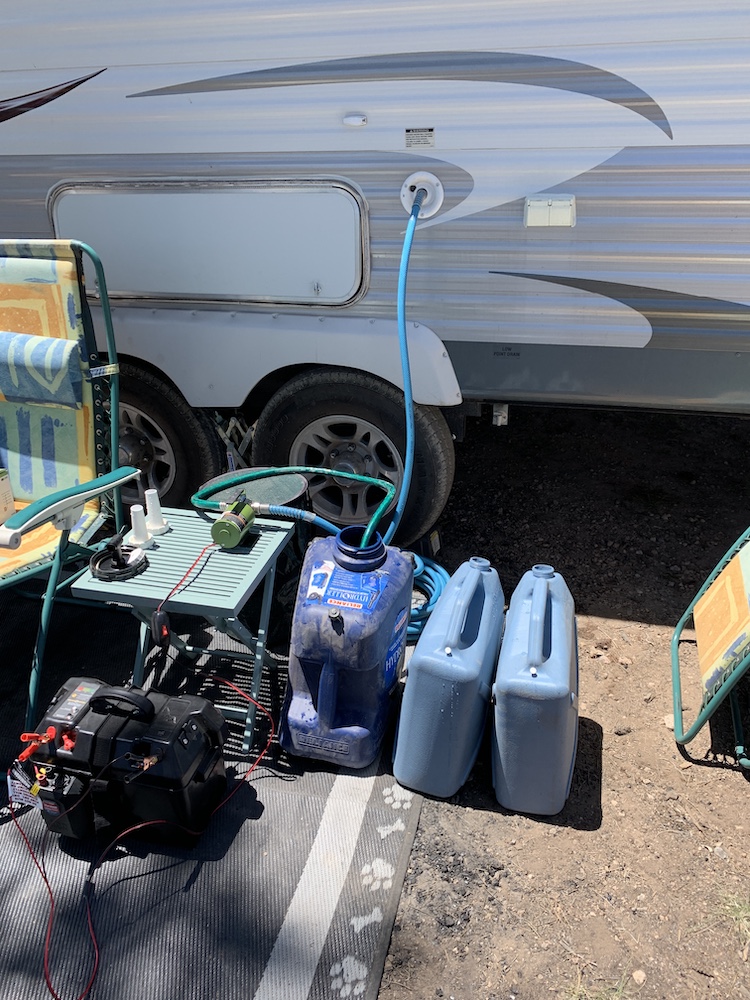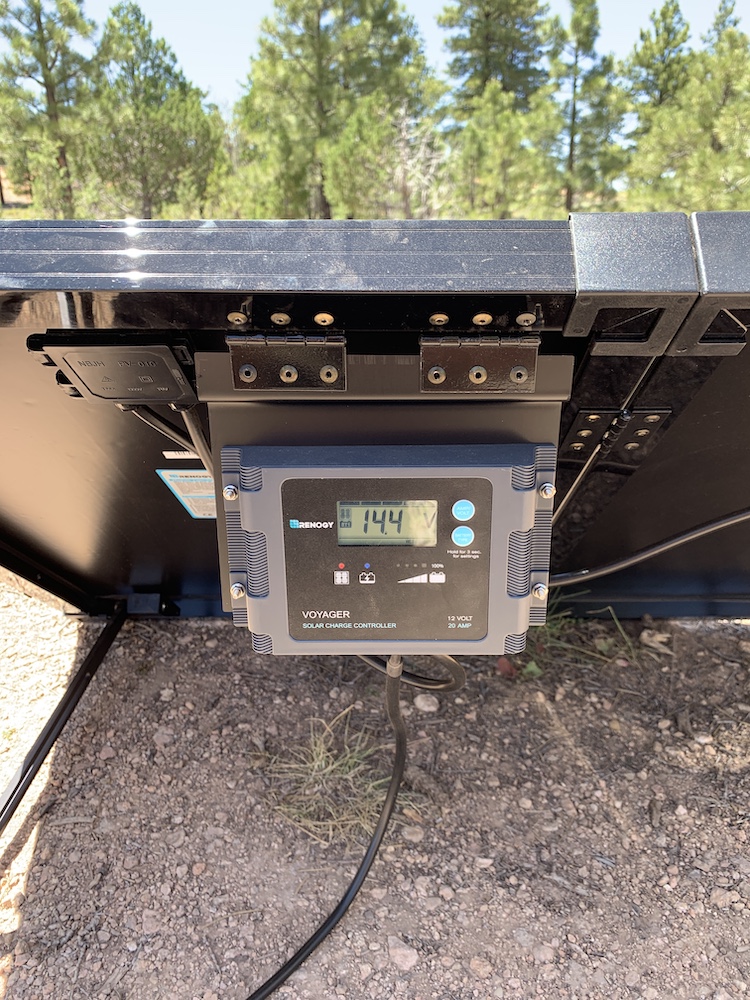Introduction
Disclaimer: At the time of writing, I’ve only been doing this for a little over 3 months so I’m certainly not an expert. I’m only writing this to show my current process for dry camping. I’m sure there are better ways of doing a lot of this, and over time I will try to post updates as I learn more.
So what is boondocking, exactly? Simply put, boondocking is dry camping (camping without water, electric, or sewer hookups) usually in a free location. Common locations include national forests, BLM land, and Walmart parking lots. This may sound unappealing at first, but boondocking has its benefits. You can’t beat the cost (free), and in my experience boondocking is usually much quieter and more peaceful than RV parks and campgrounds, especially in the national forests and BLM land. It’s closer to what people typically imagine when they think of camping.
The first few times I tried to camp off-grid I wasn’t really prepared, so the experience was a little more stressful than it would have been if I’d had the proper knowledge and equipment. As I started doing it more, I figured out what my needs were and slowly started to create a pretty good setup and process for boondocking. So that’s what I’d like to share in this post.
Finding Places to Stay
If you’re going to boondock, you’ll need a way of finding good (and legal) places to stay. So far the best resource I’ve found for discovering boondocking locations is with the app Campendium (I actually use Campendium to find pretty much all of my camp sites, including RV parks and campgrounds). I usually start the process by using the filters in the app to show only campsites that are marked as “Free”. Once I’m looking at the free sites, I then start looking at what I think is the best feature of the app, which is the reported cell service of each campsite. Users report how many bars of service they received on different mobile carriers. I work remotely, so good cell service is critical. If a spot doesn’t have service it’s immediately a no-go for me.
After finding a spot with good feedback and good cell service, I will usually start picking through the reviews, as users will often provide a lot of valuable information. They’ll report the conditions of the roads, GPS coordinates to the best sites, and alternate routes to get there in cases where Google or Apple Maps give poor directions. I take all of this into consideration when picking out a spot. If I’m really worried or unsure about it, sometimes I’ll even go as far as opening Google Earth and finding the site and inspecting it. This is a good way to get an idea of how far in you can go and where the established campsites are located. You definitely don’t want to drive your rig too deep into a forest with poor roads and not have anywhere to turn around.
Aside from Campendium there are other apps out there you can use to find boondocking locations. A couple I know of are AllStays, RV Parky, and Ultimate CG. I pretty much exclusively use Campendium though, mostly because of the cell coverage feature.
Water
Once you have a way of finding where you want to go, you’ll have to figure out where you’re going to get water and how you’re going to transport it. Finding places to get water can be tricky. Sometimes the reviews on Campendium will mention where other users went to get water (which is super nice). Other times you’re on your own. I’ve found the AllStays app to be really good for finding water and dump stations. I will usually open AllStays and look at gas stations, dump stations, and stores in the area where I will be camping and read over the comments to see if there is any mention of potable water. If I can’t find any near my destination, I’ll check along the route to see if there is anywhere I can fill up along the way. If I can’t find a place doing this, I usually will have to start making some calls. Other campgrounds, RV parks, National Parks, etc. will often let you fill up if you ask.
Once you have a place to get water you need to think about how you’ll transport it. When I first started I assumed I’d have no trouble just finding places to pull my rig in and fill the tank all the way up. I quickly realized that often the water spigots you find are not in areas you can easily access with your rig. On top of that, you may need to make a run back to the spigot to get more water, and you won’t want to hitch up and leave your campsite to do that. So you need some kind of container that you can fill and transport back to your rig.
Right now I just have 3 containers that add up to 20 gallons. Eventually I’d like to get a 30+ gallon bladder, but what I have works well for now. I always keep my containers in my truck, along with a hose, just in case I’m out somewhere and see a spot to fill up.

The only problem with filling from containers is that it’s ridiculously hard to get the water from the container into my RV tank. The port to fill the RV is about 4 feet off the ground and is a small hole, so lifting 8 gallons of water and dumping it in there was almost impossible. To solve this I ended up buying a small, cheap water pump from Harbor Freight that I hook up to a battery.

Power
Electricity is another big concern while boondocking. Even if you don’t plan to use many appliances, you’ll still need a way of keeping your RV battery charged so that you can run your lights and water pump. When I first started out I thought I’d be fine with just a generator. I did a lot of research and picked up the Predator 3500 from Harbor Freight

I was worried about leaving my only source of electricity outside and totally exposed to the elements, so I decided to build a simple shelter out of PVC, paracord, and a tarp. I can quickly tear this down and set it up and it all rolls up into a nice bundle. This turned out to be a really smart idea (see my experience near Durango, CO).

The Predator 3500 is an awesome generator that has served me well, but after a while it gets annoying having to start the generator every time you need to charge your laptop or phone. It’s also not really an efficient way of charging the RV house battery. Eventually I decided I needed to invest in solar so that I can slowly charge my batteries all day long, without having to worry about fuel or noise. I wasn’t quite ready to make the leap to permanent solar mounted on the roof, so I ended up going with a 100w foldable Renogy panel.


This just hooks up to my battery with alligator clips and so far it has worked great. I also put together a battery pack out of a 12v marine battery and an inverter (possibly another post on that sometime) and I can easily move the alligator clips to that and charge it with solar as well. Now I really only have to run the generator to use appliances like the toaster, TV, air conditioning, etc.

Eventually I hope to do a full solar install that would allow me to run many of these appliances without having to use the generator. For now this was the simplest and most cost effective solution for me, and it’s working well so far.
Edit: I have since added 800W of solar to the roof of my RV
Refrigeration
As with most RVs, the refrigerator in my rig can be switched from electric to gas. So the entire time I’m boondocking I keep the switch in the gas position. Surprisingly it doesn’t seem to use much propane. I can run this, the water heater, and furnace often for a couple weeks without refilling (depending on the weather). AllStays is also my favorite resource for finding places to refill propane tanks.

Other Tips
Location, water, and power are the main aspects of boondocking that I’ve had to figure out by trial and error so far. Aside from that, I’ve learned a couple other useful things that don’t really fit into any of those categories.
Lighting
Replacing all the light bulbs in your rig with LED is a cheap and easy way to save power. LED bulbs use much less energy and don’t heat up like standard bulbs, so they are all around much better. I got this 20 pack from Amazon and they’ve worked great so far. I tried both the “yellow” and “white” and the white were way too bright and “sterile” looking for me. I preferred the more natural color of the yellow. It’s basically the same color as the original lights.
I also picked up a couple strands of solar LED lights from Harbor Freight (I promise this post isn’t just an advertisement for Harbor Freight). These have been surprisingly useful. I put them around my door or in other places in the campsite to give some extra lighting at night and to help me easily spot my campsite if I’m driving back in the dark.

I’ve also strung the LED lights up inside my generator shelter so that I can easily see what I’m doing if I have to go out and start or refuel the generator when it’s dark.

Pets
Typically I don’t like to leave my dog alone in the rig unless I have an electric hookup and can run the air conditioning, but sometimes I’ll be in a place where the weather is nice enough I feel it’s safe to leave him. However, even with hookups the electrical at campgrounds can sometimes be unreliable as I’ve had the power go out on several occasions. Regardless of whether I have hookups or not, I like to know that my dog isn’t being roasted alive inside my rig, so if it gets hot in there I want to be alerted. To solve this problem I bought the Temp Stick on Amazon.
This just connects to my WiFi hotspot and constantly monitors the temperature in the rig. I can set alerts so that if it gets over a certain temperature it will text/email me. It also sends me alerts if it loses connection.

In the case that something were to happen and I was too far away to get there, I have this key lock box and could call someone near the campsite and give them the combination.

Footwear
Crocs are the ideal boondocking footwear. I think the reasons should be pretty obvious.

Conclusion
Like I said in the disclaimer, I’m by no means an expert on any of this (yet). However, I know that getting started in the RV world can be daunting, especially if you’re interested in boondocking, so I thought sharing my experiences and what I’ve learned so far could be valuable to someone. As I go I’m sure I will continue to learn and will try to keep posting my findings.